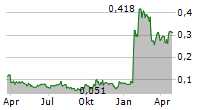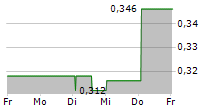
WHITE ROCK, BC / ACCESSWIRE / April 2, 2024 / TDG Gold Corp. (TSXV:TDG) (the "Company" or "TDG") is pleased to provide a second targeting update focused on the copper-gold-molybdenum ("Cu-Au-Mo") porphyry potential within TDG's ~53 square kilometre ("sq.km") Baker Complex, Toodoggone District, B.C. The North Quartz target area1 (Figure 1) is located ~4 km west of the Trident target1 (see news release Mar 07, 2024) and is bounded by TDG's 100% owned Drybrough target to the north and TDG's former producing Baker Mine to the southwest.
North Quartz historically2,3 had only shallow drillholes, all reporting appreciable base metal concentrations (Table 1). In 2023, TDG assayed for base metals in historical drillcore from the Baker B-Vein and demonstrated up to 100 metres ("m") of > 1.0 % copper equivalent5 ("CuEq") from near surface (news releases Jul 25, Aug 15 and Sep 06, 2023). In 2021, TDG completed two diamond drillholes at its 100% owned Drybrough target with both showing anomalous base metals (news release Apr 13, 2022).
This more modern drill information has been combined with historical and modern soil geochemistry and geophysics (Figure 2) to vector towards a potential porphyry target located beneath North Quartz in a road accessible target area covering at least ~ 5.0 sq.km.
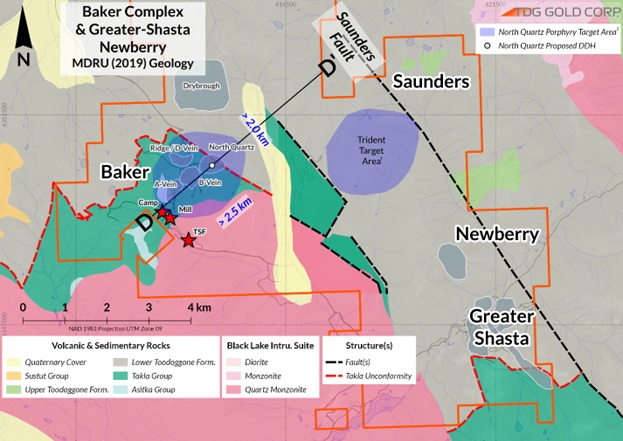
The Baker-North Quartz target area1 is road accessible and located > 1 km from TDG's Baker camp mill and TSF infrastructure. The target area1 is on the north and south flanks of a prominent iron-oxide, gossanous, west-northwest trending ridge (Figure 3) adjacent to a regional scale unconformity (now faulted) between the Toodoggone Formation and the Takla Group volcanic rocks; analogous to the 'Kyba-Nelson Red Line' unconformity which hosts deposits in the Golden Triangle area of B.C.
Steven Kramar, TDG's VP Exploration, commented: "As we continue our systematic evaluation of our holdings in the Toodoggone, there's compelling data suggesting the Baker Complex has the potential to host one or more copper-gold porphyries. The area is characterized by anomalous base and precious metals in addition to porphyry pathfinder elements such as molybdenum and tellurium, in all geological materials sampled and geophysics suggests the magnitude and geometry of a large intrusive body at depth. The series of Baker Complex target evaluations has already provided two priority drill targets, and we are still evaluating the remaining areas."
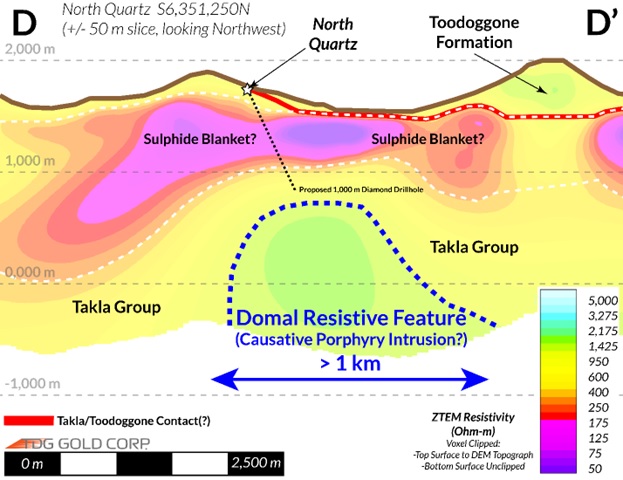
Prior Exploration Work
The North Quartz target area1 was discovered in the early 1970s and had several generations of ground-based prospecting and sampling campaigns outlining anomalous copper-molybdenum-lead-zinc-gold-silver ("Cu-Mo-Pb-Zn-Au-Ag") concentrations in soil samples, stream sediment samples draining the area, trenches, and shallow drill holes. At least 7 precious and base metal rich quartz-sulphide veins were identified with orientations orthogonal to the Baker A- and B-Veins, suggesting the mineralization may be related, but not directly to the historical Baker Mine.
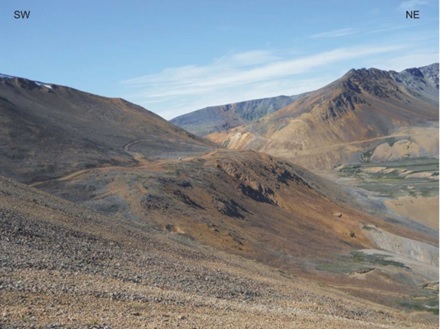
Historical Exploration
Historical soils from the North Quartz target area1 outline an open ended 400 m x 450 m multi-element soil anomaly defined by Cu > 100 part per million ("ppm") (ranging from 120-375 ppm); Pb > 100 ppm (ranging from 60-1320 ppm); Zn > 100 ppm (ranging from 100-255 ppm); Mo > 3 ppm (ranging from 3-300 ppm); Ag > 1.5 ppm (ranging from 1.5-9 ppm) and Au >20 parts per billion ("ppb") (ranging from 20-180 ppb).
Historical drilling2,3 included completion of 2,930 metres in 28 shallow holes, of which only 23 % was assayed4 (assayed core / total hole length) for precious metals and an even smaller amount for base metals. The length weighted average ("LWA") grade of all the available assayed core is 0.15 % combined Cu+Pb+Zn with numerous intervals showing highly anomalous base and precious metals (Table 1).
TDG Exploration
TDG completed an airborne ZTEM, magnetics and radiometric survey over the entire Baker Complex and Greater-Shasta Newberry in 2021. Data outlines a large domal high resistivity feature at depth, interpreted to be an intrusive body overlain by a tabular very low resistivity feature that is interpreted to be the 'sulphide blanket' characteristically above mineralizing porphyry intrusions (Figure 2).
An airborne hyperspectral survey (completed in 2022) indicates apparent zonation from magnesium-rich chlorite to iron-rich chlorite across the area and a broad zone of exhibiting a spectral signature of alunite-silica that are typical in the tops of porphyry copper systems. In 2023, TDG conducted a lithic drainage sampling ("LDS") program (news release Feb 28, 2024) and samples from small catchment drainages sourced in the target area produced results with highly anomalous concentrations of: (i) Cu (92-456 ppm), (ii) Mo (2-11 ppm), (iii) Zn (98-513 ppm), (iv) Au (50-2,950 ppb), and, (v) Ag (0.4-2.62 ppm). The upper limit of these concentrations falls within the top 10 % of the overall survey sample population.
Also in 2023, a ground based very low frequency electromagnetics ("VLF-EM") and magnetic survey was completed, and final data interpretation is underway.
Table 1 - North Quartz Drillhole assay summary.
Hole ID | Incl. | Bearing | EOH | Assayed | Assayed | Length-Weighted-Average ("LWA") Grade2,3 (ppm) | |||||
(°) | (°) | (m) | (%) | (m) | Au | Ag | Cu | Pb | Zn | Mo | |
| BK75-15 | -45 | 194 | 63.1 | 26 | 16.4 | 0.14 | 3.95 | N/A | N/A | N/A | N/A |
| BK75-16 | -54 | 014 | 63.1 | 9 | 5.8 | 0.14 | 4.48 | N/A | N/A | N/A | N/A |
| BK75-17 | -45 | 194 | 66.1 | 29 | 19.2 | 0.17 | 2.50 | N/A | N/A | N/A | N/A |
| BK75-18 | -45 | 198 | 63.1 | 8 | 5.1 | 0.15 | 2.32 | N/A | N/A | N/A | N/A |
| BK75-19 | -70 | 018 | 62.8 | 12 | 7.3 | 0.13 | 2.78 | N/A | N/A | N/A | N/A |
| BK75-20 | -45 | 198 | 63.1 | 24 | 14.9 | 0.18 | 6.46 | N/A | N/A | N/A | N/A |
| BK81-05 | -45 | 210 | 177.4 | 4 | 6.4 | 0.17 | 2.80 | N/A | N/A | N/A | N/A |
| BK81-11 | -45 | 230 | 153.0 | 9 | 13.5 | 0.53 | 7.74 | N/A | N/A | N/A | N/A |
| BK87-20 | -45 | 320 | 123.7 | 20 | 24.8 | 0.07 | 0.94 | N/A | N/A | N/A | N/A |
| BK87-21 | -60 | 140 | 93.3 | 15 | 13.6 | 0.13 | 8.28 | 89 | 2209 | 3173 | N/A |
| BK88-08 | -60 | 320 | 166.7 | 12 | 20.0 | 0.08 | 4.86 | 226 | 2587 | 2088 | N/A |
| BK88-09 | -45 | 130 | 96.6 | 19 | 18.0 | 2.18 | 78.59 | 98 | 575 | 848 | N/A |
| BK88-10 | -60 | 130 | 121.0 | 27 | 32.8 | 0.04 | 3.32 | 89 | 117 | 184 | N/A |
| BK88-11 | -45 | 130 | 75.3 | 29 | 22.2 | 0.02 | 2.74 | 91 | 107 | 260 | N/A |
| BK88-12 | -45 | 130 | 57.0 | 47 | 26.9 | 0.05 | 8.49 | 100 | 262 | 424 | N/A |
| BK88-13 | -60 | 130 | 65.8 | 27 | 18.0 | 0.06 | 4.62 | 239 | 254 | 392 | N/A |
| BK88-21 | -45 | 220 | 75.3 | 28 | 20.7 | 0.01 | 0.88 | 68 | 16 | 110 | N/A |
| BK88-22 | -50 | 090 | 78.3 | 25 | 19.3 | 0.07 | 9.86 | 144 | 404 | 597 | N/A |
| BK88-23 | -50 | 110 | 82.3 | 18 | 14.7 | 0.03 | 2.41 | 158 | 50 | 148 | N/A |
| BK88-24 | -60 | 110 | 89.9 | 20 | 18.0 | 0.02 | 5.18 | 106 | 160 | 255 | N/A |
| BK98-18 | -45 | 130 | 120.7 | 30 | 36.3 | 0.23 | 4.77 | N/A | N/A | N/A | N/A |
| BK98-19 | -38 | 130 | 99.4 | 15 | 14.8 | 0.00 | 6.92 | N/A | N/A | N/A | N/A |
| BK04-29† | -60 | 030 | 90.5 | 96 | 86.9 | 0.06 | 2.82 | 252 | 269 | 610 | 9.5 |
| BK04-30 | -75 | 030 | 100.6 | 18 | 18.0 | 0.06 | 3.64 | 311 | 331 | 627 | 28.9 |
| BK04-31 | -60 | 030 | 88.4 | 23 | 20.7 | 0.06 | 5.45 | 290 | 538 | 1111 | 13.4 |
| BK04-32 | -60 | 030 | 100.6 | 20 | 20.3 | 0.56 | 23.72 | 668 | 430 | 1313 | 30.0 |
| BK04-33 | -75 | 030 | 109.8 | 22 | 24.3 | 0.07 | 3.97 | 181 | 204 | 520 | 22.8 |
| BK17-05 | -45 | 038 | 382.8 | 16 | 61.4 | 0.04 | 2.28 | 171 | 270 | 479 | 10.3 |
| Total | 2929.7 | 620.5 | |||||||||
| LWA % | 23 | ||||||||||
| LWA Grade | 0.20 | 7.74 | 193 | 517 | 773 | 19 | |||||
*Intervals are Length Weighted Averages ("LWA"). True width unknown, and core recovery is unknown.
**LWA results were built as an aggregate of all data that was assayed.
***Calculated LWA results are truncated to significant 2 decimal places for Au/Ag (ppm)/ and the nearest integer for Cu/Pb/Zn/Mo (ppm).
****Calculated LWA results may not sum due to rounding.
†Indicates 2023 Assay Data.
Geological Interpretation
North Quartz is situated along the northeastern contact of the Baker Quartz Feldspar Porphyry stock to the southwest and augite porphyritic andesite and basaltic lava flows of Takla Group to the northeast, adjacent to a regional scale fault that brings Toodoggone volcanics in contact with the Takla on the north valley slope edge.
The Toodoggone-Takla contact is a highly prospective horizon for mineralized systems as this contact is thought to be the analogy of the Stuhini-Hazelton contact where prolific deposits have been discovered in the Golden Triangle, on the western flank of the Bowser Basin. High concentrations of base and precious metals in geological materials suggest a base-metal rich system is close by. Highly altered rocks and mineralized dikes coincident with the ZTEM geophysical responses could be related to an interpreted causative intrusion, appearing as a buried, dome-like high resistivity feature covered with 'blanket-like' zone of lower resistivity. The low resistivity feature is interpreted to be a zone of higher sulphide content associated with the phyllic (quartz-sericite-pyrite) altered cupola of the interpreted intrusion, (Figure 2) consistent with field observations.
Drillcore host rocks consist of porphyritic augite andesite, aphanitic andesites, lithic tuffs, fragmental volcanics, siltstones, dacites and dykes of varying compositions, most of them strongly altered by silica + potassium feldspar ("K-spar") + epidote + chlorite + pyrite with sulphide mineralization consists of pyrite, sphalerite, galena, and chalcopyrite. Vein and vein selvage mineralogy is suggestive of a complex hydrothermal environment with dominant assemblages of disseminated chalcopyrite and quartz-chalcopyrite and subordinate magnetite + pyrite assemblages.
Qualified Person
The technical content of this news release has been reviewed and approved Steven Kramar, MSc., P.Geo., Vice President, Exploration for TDG Gold Corp., a qualified person as defined by National Instrument 43-101.
1Mineral Exploration/Exploration Target Area(s): Exploration targets and/or Exploration zones and/or Exploration areas are speculative and there is no certainty that any future work or evaluation will lead to the definition of a mineral resource.
2Historical Data: This news release includes historical information that has been reviewed by TDG's qualified person (QP). TDG's review of the historical records and information reasonably substantiate the validity of the information presented in this news release; however, TDG cannot directly verify the accuracy of the historical data, including (but not limited to) the procedures used for sample collection and analysis. Therefore, any conclusions or interpretations borne from use of this data should be considered too speculative to suggest that additional exploration will result in mineral resource delineation. TDG encourages readers to exercise appropriate caution when evaluating these data and/or results.
3Historical Drillcore Sampling & Assay Methodology: Historical drillcore was geologically logged with lithologies identified and notable geological features recorded. Historical drillcore was split in half (and in rare cases sawn in half) along sample intervals (lithology and mineralization dependant) generally less than 3 m. Chemical analysis was performed dominantly for precious metal analysis (Au and Ag), and infrequently for base metals (Pb, Zn, Cu), and rarely for major elements and trace elements. Historically, different commercial laboratories were utilized in addition to an assay lab at Baker Mine Site. These lab facilities may or may not have had accreditation and in all cases accreditation (if applicable) pre-dated current ISO standards. Over that period, a variety of digestion and assay methods were used, including atomic absorption, fire assay atomic absorption, aqua regia atomic absorption and aqua regia ICP with varying detection limits. Reference materials (if any) were inserted at the analytical level and thus were unblind to the facility processing the samples.
4Unassayed Historical Drillcore: Historical drillcore intersections, lengths or intervals referenced for assay or geological analysis may not be available or suitable for sampling. Historical drillcores were inherited with the project and TDG provides no guarantees or warranties that these drillcores are part of the historical inventory, are available and/or have not degraded to a state that would render them wholly unusable for the purposes of scientific investigation. TDG provides no warranties/guarantees that these historical unassayed drillcores host precious or base metal mineralization.
5 Copper Equivalent (CuEq): Copper Equivalent is used for illustrative purposes to express the combined value of Au, Ag and Cu as an equivalent of Cu on an in-situ basis. Calculations are uncut, and actual prices and recoveries (following metallurgical test work) may differ from these assumptions which would change the equivalent value. Price assumptions (approximately in line with the LME 3-year trailing average metal prices) of US$ of $1,800/Oz Au, $22.50/Oz Ag and $3.25/lb Cu (lb) are used with assumed metallurgical recoveries of 94.8 %, 77.2 % and 90.0 % recovery for Au, Ag and Cu, respectively. The resulting formula is:CuEq(wt.%) = ((Cu_wt.% × Cu 1% price per tonne × Cu recovery)+(Au_g/t × Au price per g/t × Au recovery)+(Ag_g/t × Ag price per g/t × Ag recovery)) / (Cu price 1 % per tonne).
About TDG Gold Corp.
TDG is a major mineral tenure holder in the historical Toodoggone Production Corridor of north-central British Columbia, Canada, with over 23,000 hectares of brownfield and greenfield exploration opportunities under direct ownership or under acquisition. TDG's flagship projects are the former producing, high-grade gold-silver Shasta and Baker mines, which produced intermittently between 1981-2012, and the historical high-grade gold Mets developed prospect, all of which are road accessible, and combined have over 65,000 m of historical drilling. The projects have been advanced through compilation of historical data, new geological mapping, geochemical and geophysical surveys and, at Shasta, 13,250 m of modern HQ drill testing of the known mineralization occurrences and their potential extensions. In May 2023, TDG published an updated Mineral Resource Estimate for Shasta (see TDG news release May 01, 2023) which remains open at depth and along strike. In January 2023, TDG defined a larger exploration target area adjacent to Shasta (Greater Shasta-Newberry; see TDG news release January 25, 2023). In 2023, TDG published the first modern drill results from the Mets mining lease (see TDG news releases September 07, 2023, September 11, 2023 and November 28, 2023).
ON BEHALF OF THE BOARD
Fletcher Morgan
Chief Executive Officer
For further information contact:
TDG Gold Corp.
Telephone: +1.604.536.2711
Email: info@tdggold.com
Neither TSX Venture Exchange nor its Regulation Services Provider (as that term is defined in the policies of the TSX Venture Exchange) accepts responsibility for the adequacy or accuracy of this release.
Forward-Looking Statements
This news release contains forward-looking statements that are based on the Company's current expectations and estimates. Forward-looking statements are frequently characterized by words such as, "demonstrate", "potential", "appreciable", "indicate", "signature", "consistent", "appear", "associate", "strong", "coincide", "presence", "prominent," "characterize," "suggest," "apparent," "associate," "interpret", "prospective", "anomaly" and variations of these words as well as other similar words or statements that certain events or conditions "could", "may", "should", "would" or "will" occur. Such forward-looking statements involve known and unknown risks, uncertainties and other factors that could cause actual events or results to differ materially from estimated or anticipated events or results implied or expressed in such forward-looking statements. Such factors include, among others: whether the geophysical, geological and geochemical results are indicative of a porphyry intrusive with or without associated mineralization; whether interpreted potential sulphide blankets are present or absent; whether the LDS sampling results are indicative of the presence of mineralization and whether or not such mineralization has economic potential; whether future exploration programs will successfully define potentially economic mineralization; the timing and availability of funding to support such exploration; accidents, labour disputes and other risks common to the mining industry; the availability of sufficient funding on terms acceptable to the Company to complete the planned work programs; delays in obtaining governmental approvals or financing; and fluctuations in metal prices. There may be other factors that cause actions, events or results not to be as anticipated, estimated, or intended. Any forward-looking statement speaks only as of the date on which it is made and, except as may be required by applicable securities laws, the Company disclaims any intent or obligation to update any forward-looking statement, whether as a result of new information, future events, or results or otherwise. Forward-looking statements are not guarantees of future performance and accordingly undue reliance should not be put on such statements due to the inherent uncertainty therein.
SOURCE: TDG Gold Corp.
View the original press release on accesswire.com

